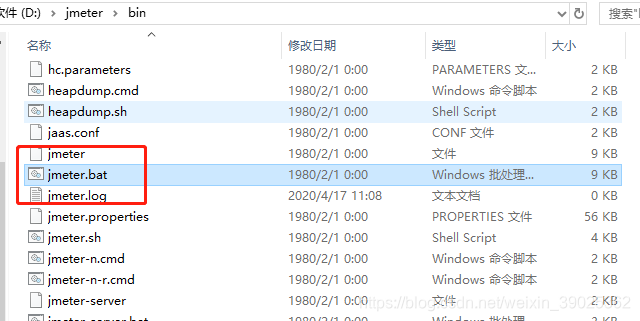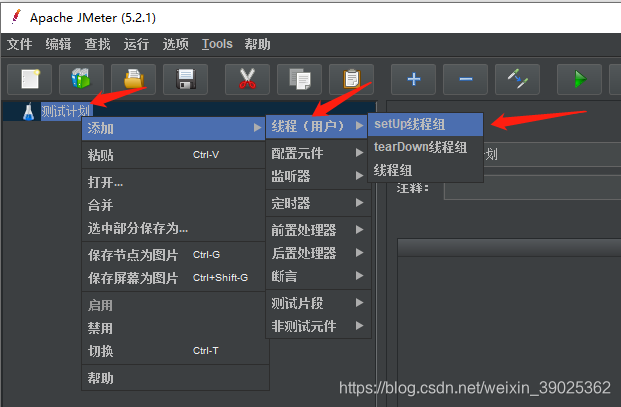jmeter下载安装与压力测试
本文共 758 字,大约阅读时间需要 2 分钟。
1.Jmeter是一款由java编写的一款开源的压力测试工具
由于JMeter是纯Java开发的软件,需要系统有安装好的jdk环境。jmeter可以进行高并发的访问,其原理就是我们所熟知的java的多线程。我们可以直接去apache的官网进行下载
2.运行Jmeter,设置语言为中文
windows系统双击jmeter.bat即可运行jmeter
 设置语言 Options->Choose Language->Chinese
设置语言 Options->Choose Language->Chinese  设置默认启动的时候为中文,修改jmeter.bat文件,把语言设置为中文,区域设置为中国,这样就可以设置默认启动时为简体字了
设置默认启动的时候为中文,修改jmeter.bat文件,把语言设置为中文,区域设置为中国,这样就可以设置默认启动时为简体字了 if not defined JMETER_LANGUAGE ( rem Set language rem Default to zh_CN set JMETER_LANGUAGE=-Duser.language="zh" -Duser.region="CN")


3.压力测试
3.1 添加线程组
右键点击测试计划 --> 添加 --> 线程(用户) --> setUp线程组
 在线程组中可以设置线程数(并发次数)、执行时间、循环次数等参数,如模拟每秒100次并发,就可以把线程数设为100,时间设置为1秒。
在线程组中可以设置线程数(并发次数)、执行时间、循环次数等参数,如模拟每秒100次并发,就可以把线程数设为100,时间设置为1秒。 
3.2 添加HTTP请求

- 协议
- ip地址
- 端口
- 请求方式:get或post
- 编码:默认为iso-8859-1
- 请求路径
 在http信息头中,设置请求参数是json格式
在http信息头中,设置请求参数是json格式 

3.3 添加察看结果树/汇总报告

 点击执行,查看结果树视图,请求成功是绿色的,我们可以在此看到每一个请求的请求数据和响应数据
点击执行,查看结果树视图,请求成功是绿色的,我们可以在此看到每一个请求的请求数据和响应数据  查看汇总报告,它是我们并发测试的分析报告,可以在此看到我们请求响应的详细报告
查看汇总报告,它是我们并发测试的分析报告,可以在此看到我们请求响应的详细报告 
转载地址:http://xvdpz.baihongyu.com/
你可能感兴趣的文章
nginx一些重要配置说明
查看>>
Nginx一网打尽:动静分离、压缩、缓存、黑白名单、跨域、高可用、性能优化......
查看>>
Nginx下配置codeigniter框架方法
查看>>
Nginx与Tengine安装和使用以及配置健康节点检测
查看>>
Nginx中使用expires指令实现配置浏览器缓存
查看>>
Nginx中使用keepalive实现保持上游长连接实现提高吞吐量示例与测试
查看>>
Nginx中如何配置WebSocket代理?
查看>>
Nginx中实现流量控制(限制给定时间内HTTP请求的数量)示例
查看>>
nginx中配置root和alias的区别
查看>>
nginx主要流程(未完成)
查看>>
Nginx之二:nginx.conf简单配置(参数详解)
查看>>
vue中各模块加载和渲染的过程
查看>>
Nginx从入门到精通
查看>>
Nginx从入门到精通(全)
查看>>
Nginx从安装到高可用,一篇搞定!
查看>>
Nginx代理websocket配置(解决websocket异常断开连接tcp连接不断问题)
查看>>
Nginx代理初探
查看>>
nginx代理地图服务--离线部署地图服务(地图数据篇.4)
查看>>
Nginx代理外网映射
查看>>
Nginx代理模式下 log-format 获取客户端真实IP
查看>>